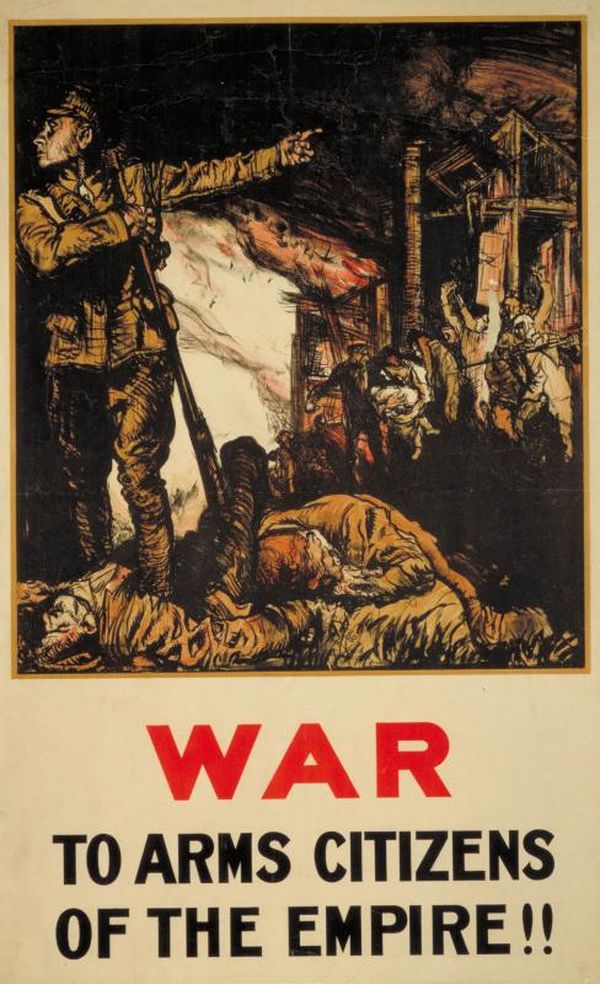
10 ways London's transport helped during wartime
Introduction
The first half of the twentieth century was dominated by two catastrophic global conflicts: the First World War (1914-18) and the Second World War (1939-45).
At the heart of one of the world’s great cities, London’s transport performed a vital role in both wars. It provided people, vehicles, industrial expertise and underground spaces to both the armed forces and the home front. It kept London moving despite air raids and used its posters to support the war effort.
Here we explore ten ways in which London’s transport contributed to the British war effort in both world wars:
1. People for the fighting fronts
As soon as Britain became involved in the First World War in August 1914, men began to volunteer for the armed forces in their thousands. Among them were men of London’s transport companies, some repurposing their skills as drivers and mechanics for military use, while others served in combat roles. Around 1,400 of them lost their lives in the conflict. During the Second World War, many men of London Transport stayed in their essential roles, but 699 staff died while serving with the forces.
2. People for the home front
With many male London transport workers in the armed forces in both world wars, women readily filled the void. In the First World War, around 18,000 women worked on London’s roads and rails, as well as taking on work behind the scenes. This set a precedent for the Second World War, when 20,000 women worked for London Transport in an even greater variety of roles.
3. Recruitment
From 1908, the London Underground began using pictorial posters as a vital tool to promote the network. As soon as the First World War broke out, Underground posters were rapidly used to aid the recruitment effort for the armed forces. This Frank Brangwyn design uses imagery of the destruction of Belgium and northern France in the opening months of the war to encourage men to enlist, like many other British propaganda posters of 1914. The Tube and wider transport network provided the ideal backdrop in promoting this messaging to millions of Londoners.
4. Vehicles in the First World War
The other obvious resource that London transport companies had to offer a major war effort was vehicles. The B type bus, the first mass produced motor bus, had been used on London’s streets since 1910. It proved vital for the British Army, being repurposed to carry troops up to the front line, particularly on the Western Front. It was even adapted for uses as varied as mobile workshops and pigeon lofts. Around 1,000 London buses of all types were repurposed for military use in the First World War.
5. Vehicles in the Second World War
London Transport vehicles proved equally adaptable during the Second World War. T type coaches, typically used on Green Line services to the suburbs and surrounding countryside, made ideal converted ambulances and mobile canteens. They were used for evacuating expectant mothers and vulnerable civilians away from London and for keeping American troops fed and watered.
6. Aircraft
Perhaps one of the lesser known contributions of London Transport in the Second World War was its role in manufacturing aircraft. From 1941 the company repurposed many of its facilities and staff to making Halifax bombers. London Transport combined with four other companies to form the London Aircraft Production Group, using its works at White City, Chiswick and Aldenham. Components were assembled at Leavesden airfield. By 1945 over 700 aircraft had been completed.
7. Shelter for civilians
By contrast, the use of Underground stations to shelter civilians from air raids in the Second World War is perhaps London Transport’s most famous wartime contribution. The Tube network had also been used for this purpose during the First World War, when London experienced air raids for the first time. During the Blitz between September 1940 and May 1941, the Underground’s deepest stations were used every night by shelterers. London Transport was also tasked with constructing eight deep-level shelters, which were used from 1944 when London came under renewed attack.
8. Shelter for secret purposes
In the Second World War the Underground network was also used to provide shelter for vital secretive activities. The tunnels of the unfinished and paused eastern extension of the Central line between Leytonstone and Gants Hill were used to house the factory of the Plessey defence electronics company. The disused Down Street station was repurposed as a bomb-proof headquarters for the Railway Executive Committee, the body that ran Britain’s mainline railways in wartime. Down Street was even temporarily used to protect Prime Minister Winston Churchill during the Blitz.
9. Evacuation
In the days leading up to Britain’s entry into the Second World War, London Transport played a vital role. With destructive air raids widely anticipated, the British government arranged for children, expectant mothers and vulnerable people to be evacuated from major cities. In August and September 1939 around 1.25 million people left London. Most were moved by London Transport vehicles to mainline railway stations.
10. Keeping London moving
Above all the wartime contributions of London’s transport services, perhaps the most essential was their ability to keep the capital moving in the most challenging of circumstances. While doing their jobs in the Second World War, 426 staff were killed and nearly 3,000 injured. Yet despite air raids, an altered workforce, requisitioned vehicles and a lack of resources, the Tube trains, buses and trams still ran, and Londoners were still carried from A to B.
London's transport at war gallery
Many of the stories and objects here can be seen within the London’s transport at war gallery.























